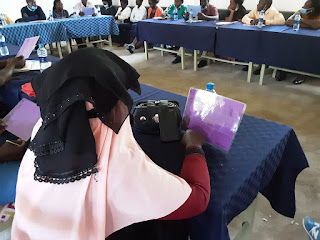THE EMBROIDERY SUCCESS STORY
One day a few years ago, Mondo donated a Janome embroidery machine to the WEFOCO tailor shop as a mean to generate income for its workers. They had seen The embroidery market as a potential for generating income, as the embroidery market in Shianda wasn't yet developed and the schools embroider their logos on their uniforms. The tailors of the village go to other cities to embroider.
Several tailors had once been trained on how to use the machine and a few volunteers contacted embroidery experts in Kisumu and Nairobi to try to understand the machine's abilities and to find an embroidery designing program for the tailors to create schools logos.
A first program called SewArt had been found online and researched on by previous volunteers. They worked on the machine but recurrent problems were happening, such as thread breaking, embroideries not being very clear, needles breaking and so on. The work to stable and clear embroideries was still on-going and far from being achieved.
Then came Sophie - a fashion designer by profession, used to working on tailoring machines and activities - who was assigned to help the tailor shop grow as a community business, reach more stability and generate more income. The embroidery challenge had been assigned to her as one of the important tasks of the project.
She first followed up on the previous volunteer's work, learned how to use the SewArt program, tried making a first logo on it.
Very quickly the recurring problems of the machine itself were fixed and the first logo design was tried on the machine and adapted accordingly.
However, the embroidery quality struggle wasn't yet cleared. Many trials to improve the first logos were made.
Examples of failed trials from the beginning.
Up to the day the WEFOCO director directed her to a new embroidery expert she had heard of in Kisumu. Sophie got in contact with Benard, the embroidery expert, and started a work relationship with him, going to visit him in his firm with all the samples they had made in the tailor shop as well as questions for improvement.
Benard was in charge of an embroidery industry in the city, working on designing school logos and embroider them on hundreds of uniform jumpers every day, using an eight head industrial embroidery machine. Very different from the WEFOCO Janome domestic embroidery machine.
One day Benard showed Sophie the designing computer program he uses in the firm - the WILCOM embroidery program. Sophie was amazed about the professionalism of its use compared to the one the previous volunteers had found for the tailors, meant for domestic amateur use rather than professional.
WILCOM embroidery designing program.
A few weeks later, Sophie acquired the WILCOM program and a computer for the WEFOCO tailor shop in the aim of generating income with the embroidery machine. A precious Mondo donation yet to be used and profitable but with great potential still.
As time passed, Sophie learned how to use the program and started designing the school logos the tailors were asking her to design for potential orders. The aim was to have logos saved inside the machine, ready to be used at any time, to make embroidery samples to present to schools and get tenders.
Once the program was mastered, the challenge was to understand and adapt the difference of outcome between the computerized embroidery files and the stitching machine outcome. Differences were discovered at every try as the domestic embroidery machine was changing the professional computer designing program files to it's standard. After many trials and adaptation, Sophie got the hang of all of it. The logos were coming out with a good quality and the tailors started having a few orders.
As that long work on the machine itself and the designing program was going on, the tailors were trained on how to use the machine with all its new abilities and practiced embroideries. They also planned an action plan as part of their Sustainable Development Project for the tailor shop.
The embroidery machine has always been a good time and money investment throughout the project.
Tailors being trained on the WILCOM designing program.
It was also amazing to see how the rural tailors were bedazzled by the computerized machine and its use, getting new skills and excited for what that knowledge and tool could bring them.
Today, the tailors have been trained on how to use computers (basic skills) and the complex WILCOM designing program. They have embroidery orders such as embroidered table cloth sets - highly popular in Kenya, school logos, name tags and firm logos.
Work still needs to be done in terms of marketing and advertising for the service. Let's give them time for that now.























































